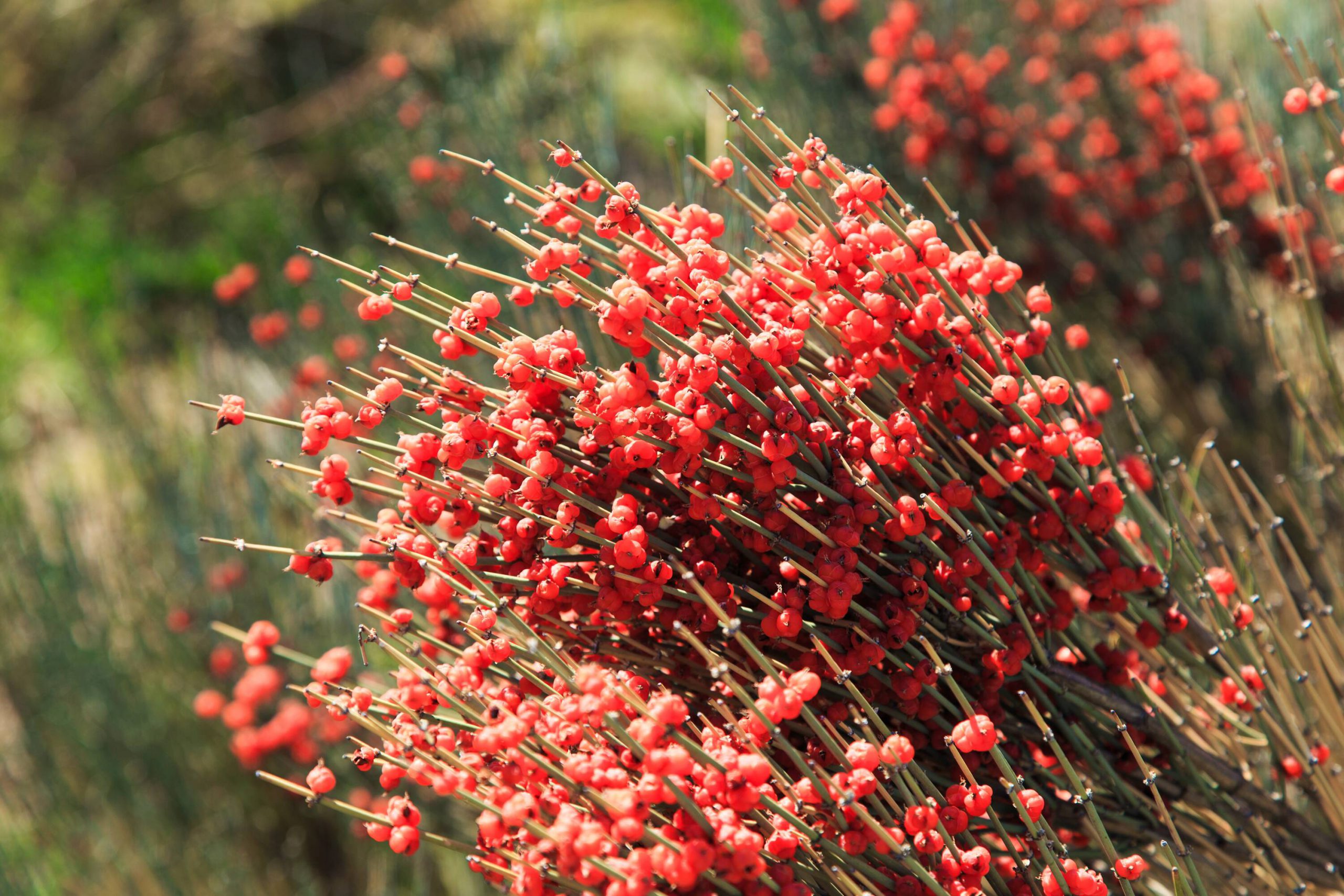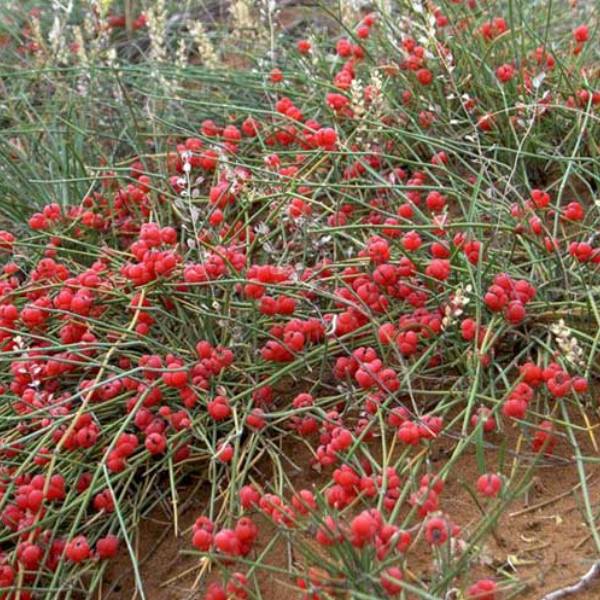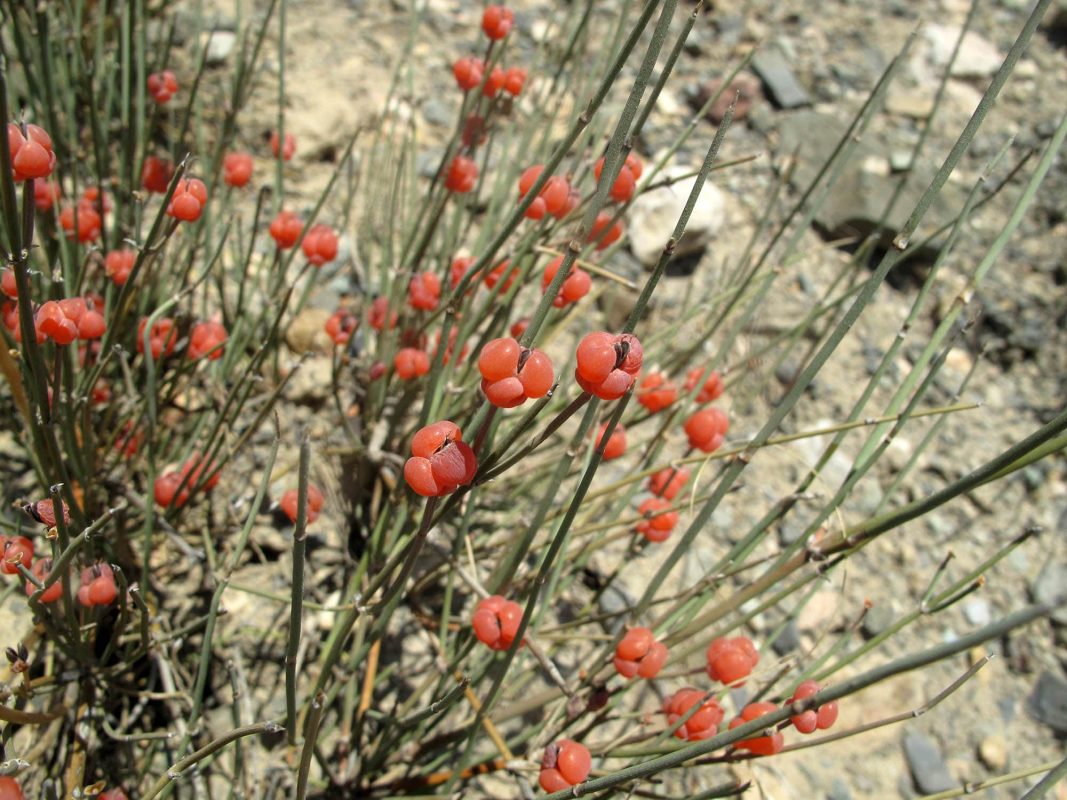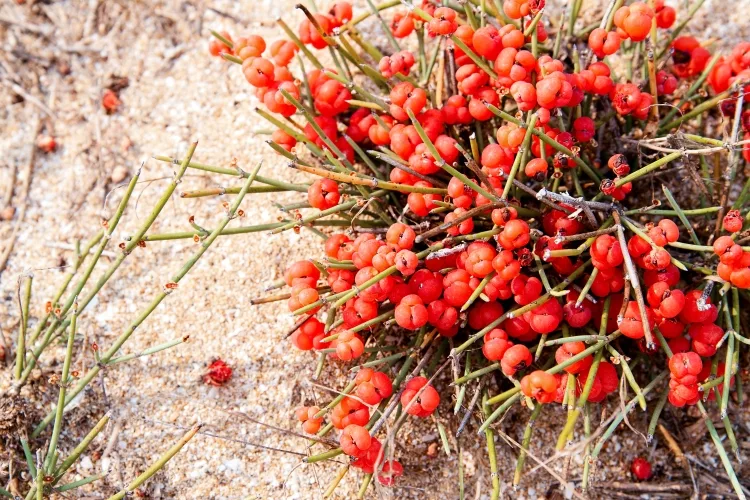Ephedra
Physical description
Members of the genus Ephedra are low, straggling, or climbing desert shrubs. The leaves, reduced to scales about one centimeter long, are opposite or whorled about the nodes of green branchlets. The bulk of photosynthesis occurs in the green stems. Reduction in leaf surface maybe related to the necessity of reducing water loss through the process of transpiration, a requirement for existence in a desert environment. Some species may have both micro strobili (male cones) and megastrobili (female cones) on the same plant, though they more commonly occur on separate plants.
Drug and supplement uses
The Ephedra alkaloids, ephedrine and pseudoephedrine – constituents of E. sinica and other members of the genus – have sympathomimetic and decongestant qualities, and have been used as dietary supplements, mainly for weight loss. The drug, ephedrine, is used to prevent low blood pressure during spinal anesthesia.In the United States, ephedra supplements were banned from the market in the early 21st century due to serious safety risks. Plants of the genus Ephedra, including E. sinica and others, were used in traditional medicine for treating headache and respiratory infections, but there is no scientific evidence they are effective or safe for these purposes.
Region
Ephedra ciliata Fischer and C. A.Mey. is a synonym of E.foliata Boiss. It is widely distributed in Afghanistan, Pakistan,Iran, and native to North Africa and Southwest Asia.Ephedra Intermedia Is spread through north and northwest of China and also distributed in arid region of Central Asia.This species is usually shrub or subshrub.Densely branched,prostrate or erect stems,commonly three or rarely two connate leaves attached at the node,stems and were bluish-green in color.



Medicinal uses
Ephedra is a medicinal preparation from the plant Ephedra sinica. Several additional species belonging to the genus Ephedra have traditionally been used for a variety of medicinal purposes, and are a possible candidate for the soma plant of Indo-Iranian religion. It has been used in traditional Chinese medicine, in which it is referred to as Ma Huang, for more than 2,000 years.Native Americans and Mormon pioneers drank a tea brewed from other Ephedra species, called “Mormon tea” and “Indian tea”.Traditionally, E. ciliata is used to cure respiratory disorders including nasal congestion, asthma and flu. The taxon is also used to treat rheumatoid arthritis.Quercetin-rich methanol extract of E.ciliata has also been found efficient against healing wounds,hence used as a source of antioxidant,antimicrobial,and anti-inflammatory.Traditionally E.intermedia are used to treat respiratory tract diseases.The taxon is also utilized as a diet supplement against obesity, besides its use as a medicine. Ephedra Species have a controversial taxonomy due to their similar morphological features that are not enough to characterize the taxa.Dietary supplements containing ephedra alkaloids have been found to be unsafe, with reports of serious side effects and ephedra-related deaths.
Biochemistry and effects
A wide variety of alkaloid and non-alkaloid compounds have been identified in various species of ephedra.Of the six ephedrine-type ingredients found in ephedra (at concentrations of 0.02-3.4%), the most common are ephedrine and pseudoephedrine,which are the sources of its stimulant and thermogenic effects.These compounds stimulate the brain, increase heart rate, constrict blood vessels (increasing blood pressure), and expand bronchial tubes (making breathing easier). Their thermogenic properties cause an increase in metabolism, as evidenced by an increase in body heat. Ephedra has been used as a weight-loss aid, sometimes in combination with aspirin and caffeine. Some studies in regulated and supervised environments have shown that ephedra is effective for marginal short-term weight loss (0.9 kg/month more than the placebo), although it was untested whether such weight loss is maintained.
Genetic
the main objective of this information collect Ephedra Spp. growing in diverse ecological zones of Balochistan,Pakistan and fingerprint the genetic variability, morphological and biochemical variation within and among various populations by using randomly amplified polymorphic DNA (RAPD),and Inter-simple Sequence Repeats (ISSR) and biochemical and morphological markers. The genetic diversity plays a key role for the survival of any species to its environment. The assessment of genetic diversity can be done by the use of morphological, biochemical,and molecular markers. Environmental variables influence morphological traits thus exhibiting a low level of diversity.Hence a consistent correlation was not found for a particular species and environmental stability.Different molecular markers can determine the level of polymorphism and genetic diversity for medicinally important plant species.The existing genetic diversity, systematic analysis and the importance of the plants is the key to conserve the taxa.
Extract Preparation
Plant was shade dried and ground into fine powder. Powder (10 g) was boiled in 200 mL of autoclaved distilled H2O for 10 min. After boiling, it was cooled down, filtered, stored at 4 °C in refrigerator and further used for phytochemical analysis and nanoparticles synthesis.

